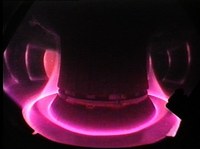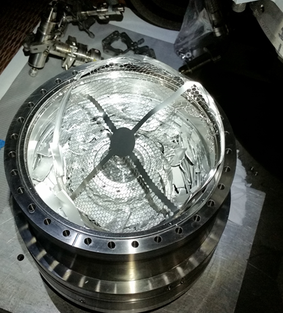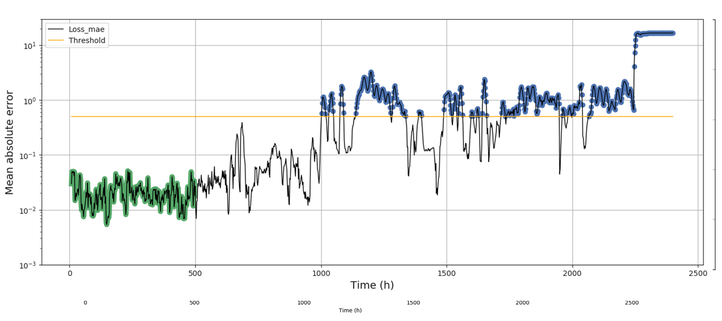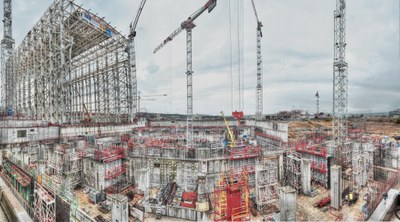Research Unit Nuclear Fusion


Introduction
Nuclear fusion reactions involve the fusing of light elements (such as hydrogen) to form heavier ones (such as helium). Nuclear fusion is the process that powers the stars, transforming mass into energy according to Einstein's formula E= m.c2.
The worldwide research on controlled thermonuclear fusion aims to realize fusion on earth, as a means to produce energy in a way that is both clean and safe. Fusion produces no greenhouse gases, no toxic or long-lived radioactive waste (only the reactor structure becomes slightly activated after a while) and neither is there any danger of major nuclear accidents like Tsjernobyl or Fukushima. Fusion is one of the few options available for sustainable energy production, to counter global warming and yet meet the steadily increasing energy demands of the 21st century. Contrary to solar and wind energy, fusion has the potential to provide large and local sources of continuous base-load power everywhere in the world.
Through the European Consortium for the Development of Fusion Energy (EUROfusion), the European Union maintains an ambitious research programme targeted at realizing fusion electricity by 2050. The main focus of the research is on magnetic confinement fusion, in particular the tokamak concept, whereby the fusion reactions take place in a hot plasma confined by strong magnetic fields. In collaboration with fusion research centres all over the world, this is presently culminating in the ongoing construction of the international fusion device ITER at the Cadarache site near Aix-en-Provence in France, as well as the design of the first fusion demonstration reactor DEMO.
 |  |  |
|---|
From left to right: inside view of the JET vessel with the ITER-like wall, the plasma in ASDEX Upgrade and a cut of the ITER vessel embedded in its cryostat harbouring the superconducting coils.
Research of the group infusion

At the UGent department of Applied Physics, the Research Unit Nuclear Fusion (infusion) has been involved in fusion research since over thirty years. Growing out of the long-standing expertise of the group in fusion diagnostics and experimentation on various fusion devices across Europe, the research presently concentrates on the rich area of fusion data science. We employ modern techniques from Bayesian inference and machine learning to study the fusion plasma and the technology of fusion devices. This combines two of the most topical and challenging issues of our time: sustainable energy supply and data science.
ITER and future fusion reactors will be very complex machines that will rely heavily on advanced control systems. In turn, plasma control depends crucially on plasma diagnostics that are required to provide reliable measurements of key plasma parameters, which is an important challenge owing to the particularly harsh environment of fusion plasmas. In addition, there is still an important lack of understanding of various aspects of tokamak and stellarator physics, necessitating a data-driven approach in many cases. Probability theory and machine learning methods have a major role to play in plasma control and plasma diagnosis, in increasing the understanding of the physics of magnetized fusion plasmas and in designing new fusion machines. State-of-the-art techniques for studying and controlling stochastic plasma phenomena, for analyzing data patterns, for modeling error propagation and for integrated data analysis have been introduced in fusion science since the last 15 years. The Research Unit Nuclear Fusion has been involved in this domain since the start of this important new trend and we have acquired a strong expertise at the front of this domain, ranging over several research activities:
- Advanced regression analysis for estimation of fusion scaling laws
- Probabilistic characterization of stochastic plasma phenomena: edge-localized modes, disruptions and plasma turbulence
- Bayesian modeling of fusion diagnostics and Bayesian tomography
- Anomaly detection and predictive maintenance
- Survival analysis for first-wall materials and modeling of material damage
- Applications to ion cyclotron heating
The research is based on solid mathematical foundations involving Bayesian probability theory and information geometry. We also employ various machine learning methods, including neural networks and deep learning.
Below is a more detailed description of each of the current research topics. (back)
Advanced regression analysis for estimation of fusion scaling laws
Scaling laws provide crucial information for the design specifications of next-step fusion devices such as ITER. They enable extrapolation of various plasma characteristics and performance measures from measurements assembled in international multi-machine databases. On the other hand, regression analysis is a ubiquitous instrument for exploration and characterization of relations between physical quantities. We have developed a new regression technique, called geodesic least squares (GLS), designed to handle significant uncertainty on the data and the regression model. It is based on minimization of the geodesic distance between the measured and predicted probability distribution of the response variable. With this technique we are contributing to the revision of historical multi-machine scaling laws for the energy confinement and the power threshold for the L-H transition. Other applications include modeling of the dependencies of intrinsic plasma rotation, ELM heat loads and width of the scrape-off layer. (back)
Probabilistic characterization of stochastic plasma phenomena
Many important phenomena in fusion plasmas exhibit a strongly stochastic character, i.e. they behave in a random and unpredictable way due to the complex underlying microscopic physics. Examples are edge-localized modes (ELMs), disruptions and plasma turbulence, all of which are presently insufficiently understood from the physical point of view, while posing many critical issues on the road towards a practical fusion reactor.
Understanding physical behavior begins with quantification and to quantify a stochastic phenomenon requires the methods of probability theory. We use a variety of probability distributions to model stochastic plasma quantities, in combination with a cutting-edge mathematical framework to describe and compare distributions. This is the framework of information geometry, wherein probability distributions are treated as points on a manifold, allowing measurement of the difference between distributions by means of a geodesic distance.
This research field is an exciting blend of plasma physics, probability theory and differential geometry, offering unparalleled new insights into the complex physics of fusion plasmas and in information theory.
Bayesian modeling of fusion diagnostics and Bayesian tomography
This research is among the core activities of the group since 2002. It concerns application of Bayesian probability theory (BPT) to modeling of fusion diagnostics in order to reduce uncertainties on derived physical quantities, combine data from various diagnostics and solve the notoriously difficult tomography problem for reconstruction of local plasma quantities. We work on charge exchange spectroscopy (CXS) with a view to the ITER core CXS system, reflectometry for density profile reconstruction and turbulence studies, and soft-X-ray spectroscopy (SXR) for real-time reconstruction of impurity concentrations and MHD mode activity. In the case of SXR, the local emissivity field is reconstructed by means of a Gaussian process method, enabling real-time capabilities for use in plasma control. (back)
 |
 |
 |
Anomaly detection and predictive maintenance
Fusion reactors will need to be operated in a stable regime without transient events such as plasma disruptions and (large) ELMs. From the point of view of machine learning, such events can be characterized as anomalous and specialized techniques exist to detect them by monitoring various diagnostic signals. If this can be done sufficiently in advance of their predicted occurrence, the plasma control system may have sufficient time to react and avoid or mitigate these events. Particularly dangerous are plasma disruptions, which are major instabilities causing excessive thermal loads and large transient forces that are potentially harmful to the operation of a tokamak and that will have to be avoided or mitigated in ITER. Disruptions can be caused by various complex mechanisms and it is very important to be able to predict them in real time and to recognize the disruption cause. We have recently developed a disruption classifier based on the discrimination of the distribution of wavelet coefficients corresponding to several predictor signals. We are also working on a reliable discrimination between different disruption types. In addition, research is ongoing in collaboration with ITER to establish a new set of predictor quantities (features) with a clear link to disruption physics and minimal dependence on machine characteristics. Finally, similar machine learning techniques are being used for predictive maintenance of subsystems and components in fusion devices. (back)
 |
 |
Survival analysis for first-wall materials and modeling of material damage
In a practical fusion device, some plasma always leaks out and comes into contact with the wall or the plasma exhaust components (divertor). In addition to the continuous bombardment from the plasma by neutrons (which carry the bulk of the fusion energy), this leads to material damage and activation. The research develops an understanding on how to optimise the materials to withstand the harsh plasma conditions in ITER and future fusion reactor. In particular, tools from Bayesian probability theory and machine learning are used to predict survival times of material components and for modeling stochastic characteristics of material damage.
Applications to ion cyclotron heating
Electromagnetic wave heating is one of the methods to obtain the tremendous plasma temperatures needed for fusion to occur. The research investigates the physics and technological aspects of ion cyclotron resonance heating (ICRH) and the processes that accompany it.
International collaborations
The Research Unit Nuclear Fusion has an extensive world-wide network of collaborations and contacts in fusion research, and is since many years recognized as an important player and a respected centre of excellence in the fusion community. Collaborations exist with various fusion laboratories in Europe and around the world, including:
- The Laboratory for Plasma Physics (LPP) at the Royal Military Academy in Brussels
- The Belgian Nuclear Research Centre (SCK.CEN) in Mol (Belgium)
- The Forschungszentrum Jülich (Germany) via the Trilateral Euregio Cluster (TEC)
- The Culham Centre for Fusion Energy (CCFE), home of the European tokamak JET.
- The Max Planck Institute for Plasma Physics (IPP) in Garching (Germany), where the tokamak ASDEX Upgrade is based.
- The ITER Organization at Cadarache (France). Our group has direct collaborations with ITER for various physics and technological studies.
PhD research opportunities
If you are interested in pursuing a PhD within the Research Unit Nuclear Fusion (infusion) at UGent, please contact Prof. Dr. Geert Verdoolaege.
 |
 |
Two views of the ITER construction site.

